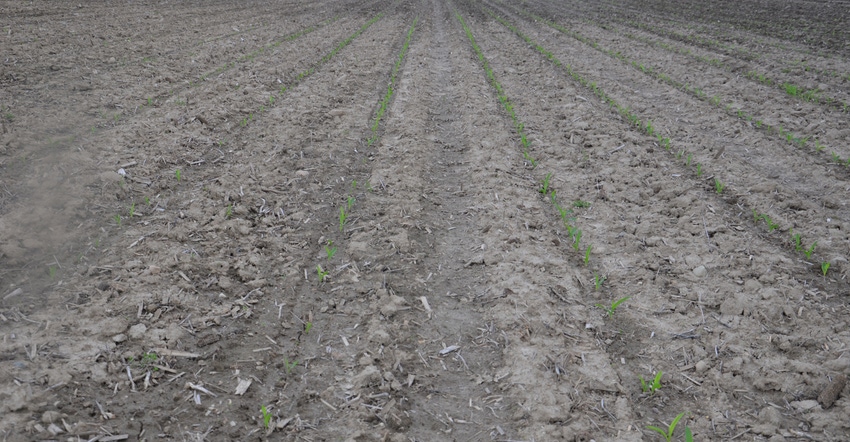
Who says lightning doesn’t strike twice in the same place? Likely no one who lived to tell about it! The start to the 2017 growing season in Indiana is eerily similar to how 2016 began.
A sharp cool spell and saturated soils interfered with germination a year ago. For example, last year’s Crop Watch field was planted on April 27, 2016, a day ahead of rain. Temperatures turned cool, with lows in the 30s. It stayed wet for several days.
The farmer planted more corn in spots where it appeared the stand would be thin. That replanting wasn’t until nearly the last week of May. Some people tore up stands and planted over in 2016. Final yield in the Crop Watch field was still 185 bushels per acre.
Get more INSIGHT: Download 17 Ways to Improve Corn Yield now!
What will happen this year remains uncertain. The Corn Watch ’17 field (which replaces Crop Watch) was planted April 20, after several days of dry weather. The farmer planted seed slightly deeper than 2 inches to reach moisture. Rains were skirting the area, and it appeared a dry spell might be setting up.
That was more than 6 inches of rain ago. Fortunately, it didn’t all fall at once. It also turned cool, but not as cool as last year.
Undoubtedly, there will be some replanting in Indiana somewhere. In fact, one farmer reports that he farms a sizable amount of bottom ground in southern Indiana. “We planted the first time for practice,” he quips.
Dig into numbers
So what does history say about whether planting April 20 was the right move or not? Remember, armchair quarterbacking with nothing invested and in hindsight is much easier than making the real decision!
Assume the next day you could plant was May 15 if you didn’t plant April 20. Check the Purdue University Corn & Soybean Field Guide for information. It’s published by the Purdue Crop Diagnostic Training and Research Center. Corey Gerber is the director of the center.
The current version of the guide refers you to “Estimating yield and dollar returns from corn replanting,” Purdue Extension publication AY-264-W. It contains a table called “Expected grain yield loss due to various planting dates and final plant population.”
Examples
Suppose that when the stand, planted April 20 at 32,000 average plants per acre, emerges, it is only 26,000 plants per acre. Assume it’s reasonably uniform. The chart indicates you could expect 97% of the original yield potential. If that was 200 bushels per acre, you’re looking at 194 bushels per acre if you leave the stand.
Another option is to tear up the stand and replant. If you plant at an average of 32,000 seeds per acre on May 15 and obtain a final population of 30,000 plants per acre, you would expect 95% of original yield. So you’re looking at 190 bushels per acre. Compared to leaving the stand, if corn is $3.50 per bushel, you’re $14 in the hole and still must cover replanting costs.
What if you planted April 20 and only 20,000 plants per acre emerged? You’ve lost 10% of yield potential, and you’re at 180 bushels per acre. If you didn’t plant at all until May 20 or can’t replant until May 20 and get 30,000 plants per acre, you can expect 182 bushels per acre. You would be ahead $7 per acre, minus replanting costs.
Here’s the kicker: Suppose you can’t plant until May 30 and get 30,000 plants per acre. Now the potential is only 162 bushels per acre due to delayed planting. That’s considerably less than an April 20 planting with only 20,000 plants per acre emerged.
Corn Watch ’17 is sponsored by Seed Genetics-Direct, Washington Courthouse, Ohio.
About the Author(s)
You May Also Like




